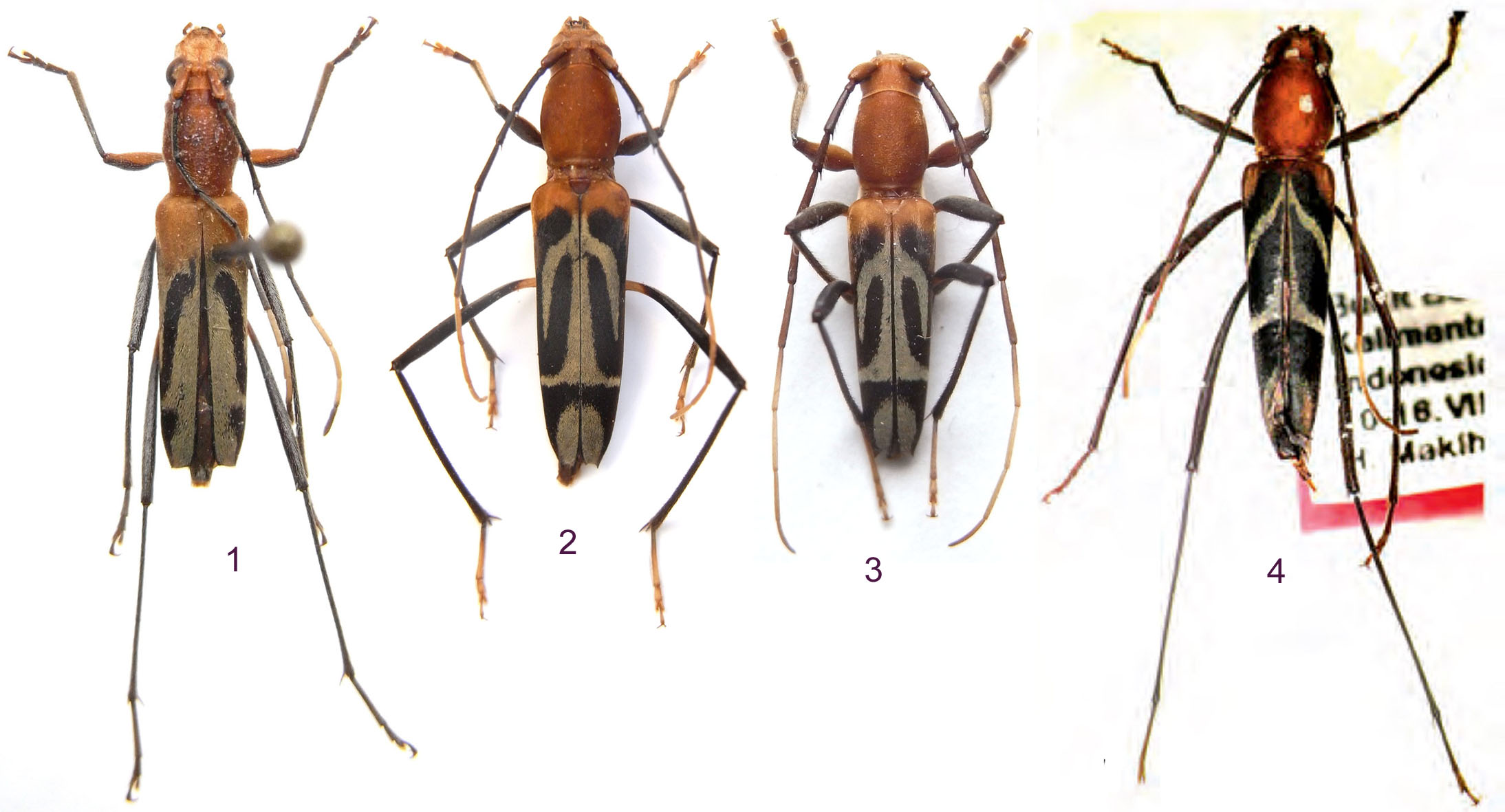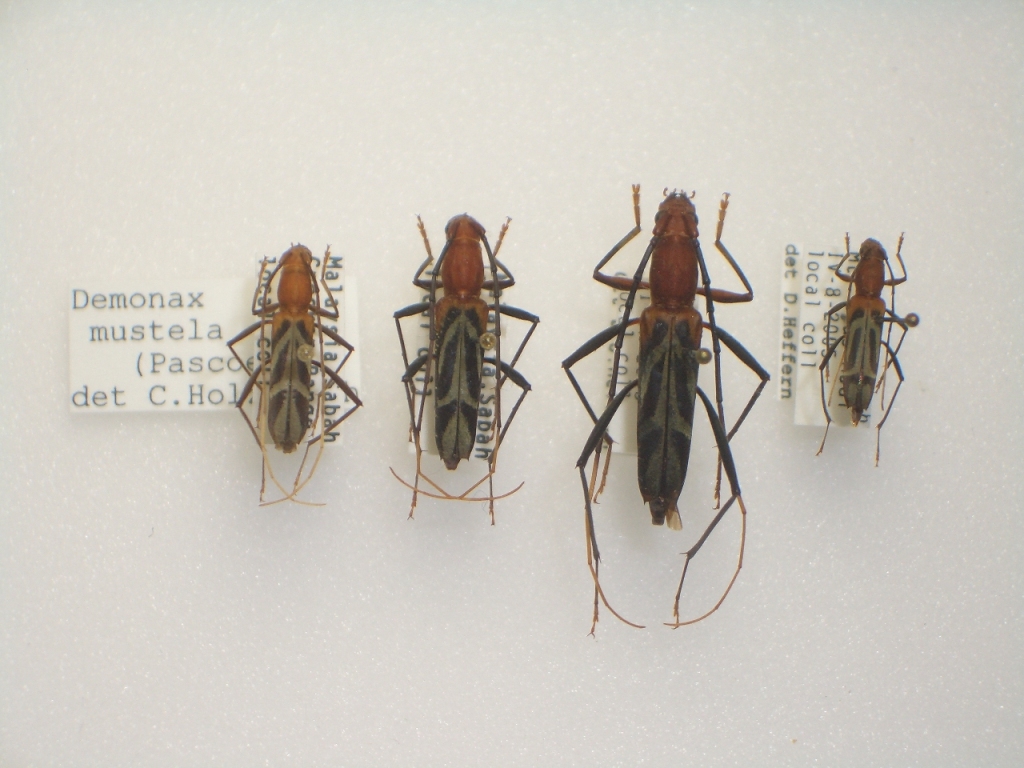| Author |
 Topic Topic  |
|
Xavier
Scientific Collaborator
    
France
12532 Posts |
 Posted - 16/02/2017 : 23:38:00 Posted - 16/02/2017 : 23:38:00



|

202.68 KB
16 mm; Mt Bawang, Kalimantan, Indonesia.
Demonax rubricus Dauber, 2016 male |
Edited by - Xavier on 18/02/2017 10:52:30 |
|
|
dryobius
Member Rosenbergia
   
USA
1900 Posts |
 Posted - 17/02/2017 : 04:48:28 Posted - 17/02/2017 : 04:48:28



|
For me, this is undoubtedly Demonax mustela (Pascoe, 1858), a species which is common in Borneo, and which has a very consistent pattern of markings on the elytra.
Interstingly, Demonax martes Pascoe, 1869 appears to be a lot like D. mustela with some of the black markings erased.
D. martes is usually 10-15mm, while D. mustela is 15-25 mm.
D. rubricus (described from one specimen) has a different pattern on the elytra from your specimen. Your specimen and the numerous specimens of D. mustela I have seen from Sabah are quite similar. |
 |
|
|
Xavier
Scientific Collaborator
    
France
12532 Posts |
 Posted - 17/02/2017 : 09:30:24 Posted - 17/02/2017 : 09:30:24



|
Thanks Dan, very interesting mimetics species !
I was hoping you answer me.
I spent a long time with the binocular to search for differences between my "Demonax mustela" and this specimen: nothing apart the shape of grey and black bands; no difference of punctuation, lenght of antennomera, etc.
To show what we talk about :

248.45 KB
1. Sarawak, 12 mm; Demonax martes Pascoe, 1869 ?
2. Kalimantan, 16 mm; Demonax mustela (Pascoe, 1858) femelle ?
3. Sarawak, 11 mm; Demonax mustela (Pascoe, 1858) male ?
4. Kalimantan, 15 mm; Demonax rubricus Dauber, 2016 holotype.
What do you think of my ID 1,2 & 3 ?
First specimen of this topic is similar to Dauber's specimen (4).
May I have here... only one species ?   |
Edited by - Xavier on 17/02/2017 09:43:05 |
 |
|
|
Xavier
Scientific Collaborator
    
France
12532 Posts |
 Posted - 17/02/2017 : 11:29:24 Posted - 17/02/2017 : 11:29:24



|

62 KB
To complete, Demonax mustela (Pascoe, 1858) Holotype from British Museum, London. |
Edited by - Xavier on 17/02/2017 11:29:53 |
 |
|
|
dryobius
Member Rosenbergia
   
USA
1900 Posts |
 Posted - 17/02/2017 : 13:03:58 Posted - 17/02/2017 : 13:03:58



|
1 = D. martes (sometime has a little more black markings than yours !!)
2 & 3 = D. mustela (always has very consistent black markings, although sometimes the specimens are very large, i.e. 25mm !)
4. Dauber's D. rubricus is a good species, unfortunately we do not know what type of variations it could have
It looks reasonable to assume that D. martes and D. mustela are very closely related and may have had the same ancestor. |
 |
|
|
Xavier
Scientific Collaborator
    
France
12532 Posts |
 Posted - 17/02/2017 : 13:23:18 Posted - 17/02/2017 : 13:23:18



|
Thank you.
Ok for 1 to 4, ...but what about the first specimen of the post ? |
 |
|
|
dryobius
Member Rosenbergia
   
USA
1900 Posts |
 Posted - 17/02/2017 : 13:32:00 Posted - 17/02/2017 : 13:32:00



|
I still believe it is D. mustela. The markings on the elytra are very close to the specimens I have from Sabah.
|
 |
|
|
Xavier
Scientific Collaborator
    
France
12532 Posts |
 Posted - 17/02/2017 : 13:49:43 Posted - 17/02/2017 : 13:49:43



|
| ok. So, with no difference of marking, Dauber species could also be a D. mustela ! |
 |
|
|
dryobius
Member Rosenbergia
   
USA
1900 Posts |
 Posted - 17/02/2017 : 20:32:34 Posted - 17/02/2017 : 20:32:34



|
Without a series of specimens, there is no help to make a good judgment. I would place your single specimen with D. mustela, and I would keep Dauber's species as valid.
Markings on Clytini will never be perfectly identical due to natural selection. |
 |
|
|
Xavier
Scientific Collaborator
    
France
12532 Posts |
 Posted - 17/02/2017 : 21:06:24 Posted - 17/02/2017 : 21:06:24



|
| I have more than one specimen like the first one, all from Kalimantan, all identical. |
 |
|
|
dryobius
Member Rosenbergia
   
USA
1900 Posts |
 Posted - 18/02/2017 : 04:16:05 Posted - 18/02/2017 : 04:16:05



|
4 Demonax mustela from Sabah.
The largest specimen is 21 mm from base of mandibles to apex of elytra.
I see 3 different shapes and patterns of markings, all similar, but not 3 different species.
Demonax mustela always has the base of the elytra reddish brown. For D. rubricus, only the humeri at the base of the elytra are reddish brown.

424.47 KB |
 |
|
|
Xavier
Scientific Collaborator
    
France
12532 Posts |
 Posted - 18/02/2017 : 10:43:27 Posted - 18/02/2017 : 10:43:27



|
Ok with you, but "changing patterns" means that D. rubricus, described on only single female specimen, could be another variation of D. mustela, just more blackish?
Did Dauber find a true feature to separate D. mustela & D. rubricus? I do not know.
|
Edited by - Xavier on 18/02/2017 10:45:47 |
 |
|
|
Andre
Member Rosenbergia
   
Germany
1740 Posts |
 Posted - 18/02/2017 : 11:59:08 Posted - 18/02/2017 : 11:59:08




|
Was sagt denn die Genitalmorphologie ???
Man kann monatelang darüber sinnieren, was ist Variabilität oder nicht. Ein Blick auf die Genitalien kann oftmals das Problem in Minuten lösen. Ich kann es wirklich nicht mehr verstehen  . .
Speziell bei schwierigen, nah verwandten Artengruppen ist die Genitalmorphologie oftmals (nicht immer !) eindeutig. So lassen sich damit Arten genial differenzieren, oftmals sogar die Gattungszugehörigkeit nachweisen (Callichromatini)!
Mittlerweile ist diese Praktik in allen Käfer Familien Standard.... nur bei den Cerambyciden wird darauf meist konsequent verzichtet.
Soweit mir bekannt haben die Clytini kaum Innensackstrukturen, doch vor allem die Parameren bieten eine weitreichende Vielfalt auf.
Francesco hat doch auch dazu eine hervorragende Anleitung ins Forum gestellt, und was bei den Lepturini funktioniert, sollte auch bei den Clytini..... und allen anderen Gruppen funktionieren.
Dazu noch ein kleiner Hinweis: Nach dem entfernen der kompletten Genitalarmatur.... diesen in einem Tropfen mit verdünntem Tapetenleim geben und die Teile separieren. Somit wird ein "wegspringen" einzelner Teile verhindert !
Wir haben in diesem Forum einen doch recht hohen wissenschaftlichen Stand erreicht, somit sollte diese Praxis auch Standart sein !!! |
 |
|
|
Xavier
Scientific Collaborator
    
France
12532 Posts |
 Posted - 18/02/2017 : 12:09:42 Posted - 18/02/2017 : 12:09:42



|
Du hast ganz Recht Andre.
...aber für diese Arten habe ich nicht genug Proben zu vergleichen. |
Edited by - Xavier on 18/02/2017 12:19:24 |
 |
|
|
dryobius
Member Rosenbergia
   
USA
1900 Posts |
 Posted - 18/02/2017 : 13:16:42 Posted - 18/02/2017 : 13:16:42



|
I see Dauber's specimen as having a pattern that is quite unique and unlike any of the D. mustela which I have seen.
Some people did not find the genitalic structure of Cerambycidae to be an effective means of separation (i.e.Linsley, Chemsak). Perhaps it works well for you in your groups. Obviously it is time-consuming and requires patience and skill (are you a neurosurgeon  ), a good binocular microscope... something which not all of us have. Does it work well to separate subspecies? Is there any variation in a species that ranges from Europe to Japan? Countless Dorcadion and Cortodera descriptions lack any mention of genitalia. I am not trying to ridicule your methods, however it is not a priority for me to learn a new skill. ), a good binocular microscope... something which not all of us have. Does it work well to separate subspecies? Is there any variation in a species that ranges from Europe to Japan? Countless Dorcadion and Cortodera descriptions lack any mention of genitalia. I am not trying to ridicule your methods, however it is not a priority for me to learn a new skill.
I have some American colleagues that are completely focused on collecting material and curating it to the best level possible. They have countless new species from the tropics and attempt to find more every year, while perhaps only describing a small fraction of their discoveries.
I guess I am in the latter group. Putting a name on a species is less important than preserving it for science. I am content to allow someone yet to be born to identify / describe the numerous strange / new species in my collection as long as I can leave them in a good museum with "accurate location" data.
|
 |
|
|
Andre
Member Rosenbergia
   
Germany
1740 Posts |
 Posted - 18/02/2017 : 14:38:50 Posted - 18/02/2017 : 14:38:50




|
Hallo Dan
Das sich frühere Cerambycidenspezialisten nicht mit den Genitalstrukturen befasst haben ist schade..... damit müssen wir leben. Es hätte auch ihnen (und im jetzt auch uns) die Arbeit sehr erleichtert.
Es erfordert weniger Geschick und Zeit als du glaubst.... und nein.... ich bin kein Chirurg.... bin Dachdecker  . Es spart aber sehr viel Zeit beim determinieren der Art und hätte uns vieleicht schon viele sinnlose Neubeschreibungen erspart. Man braucht auch kein sonderlich großes Microskop..... bei den Parameren sollte eine Lupe fast schon reichen. Jeder der am determinieren seine Freude hat, sollte diese Möglichkeit doch nutzen !!! Ich bin mir sicher, das ihr in euren großen Serien zahlreiche "Überraschungen" erleben werdet. . Es spart aber sehr viel Zeit beim determinieren der Art und hätte uns vieleicht schon viele sinnlose Neubeschreibungen erspart. Man braucht auch kein sonderlich großes Microskop..... bei den Parameren sollte eine Lupe fast schon reichen. Jeder der am determinieren seine Freude hat, sollte diese Möglichkeit doch nutzen !!! Ich bin mir sicher, das ihr in euren großen Serien zahlreiche "Überraschungen" erleben werdet.
Und das heute noch Arten und Unterarten und Unter - Unterarten und..... beschrieben werden, ohne auf die Genitalien einzugehen ist grob fahrlässig  . .
Das sammeln und korrekte kuratieren ist sicherlich auch wichtig.... das steht ja außer Frage. Ohne dem würden die Bearbeiter vieler Gruppen gar nicht arbeiten können. |
 |
|
 Topic Topic  |
|


